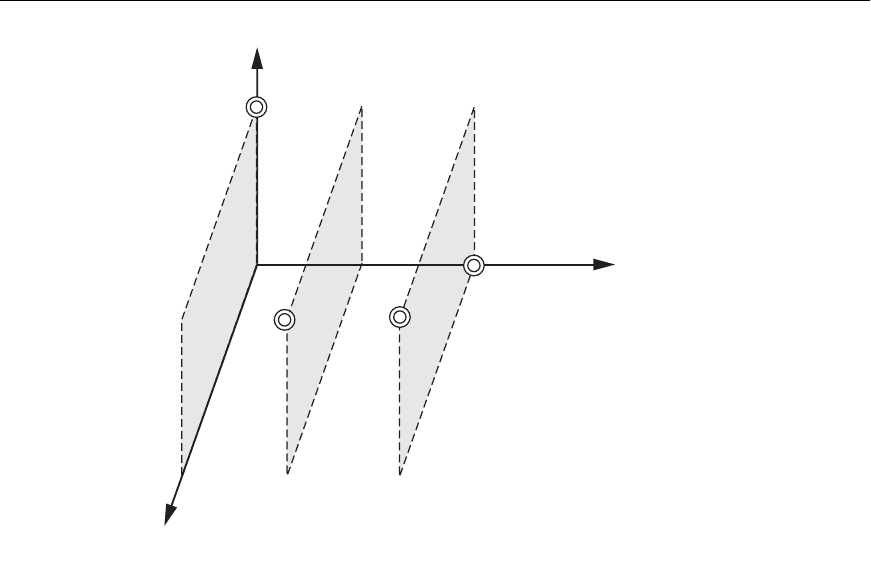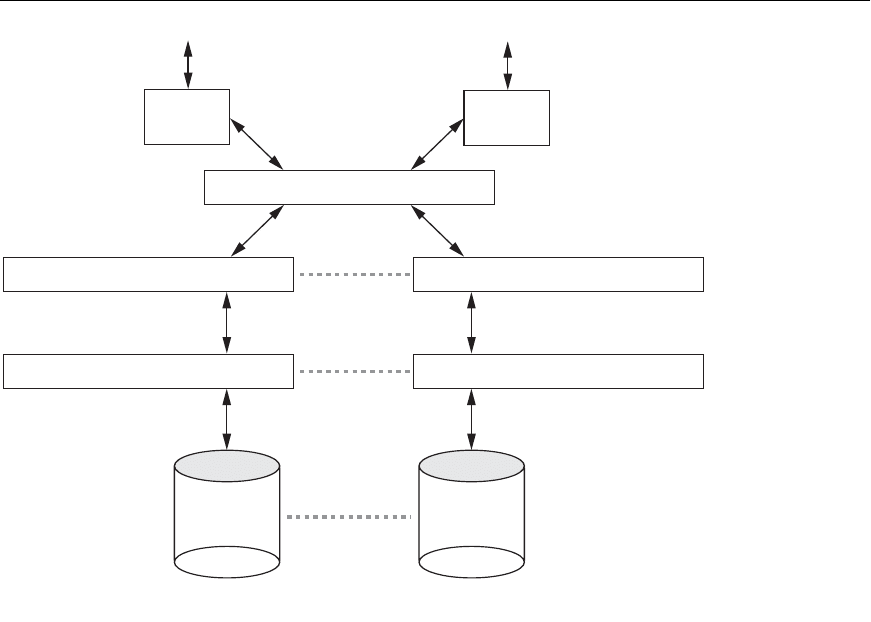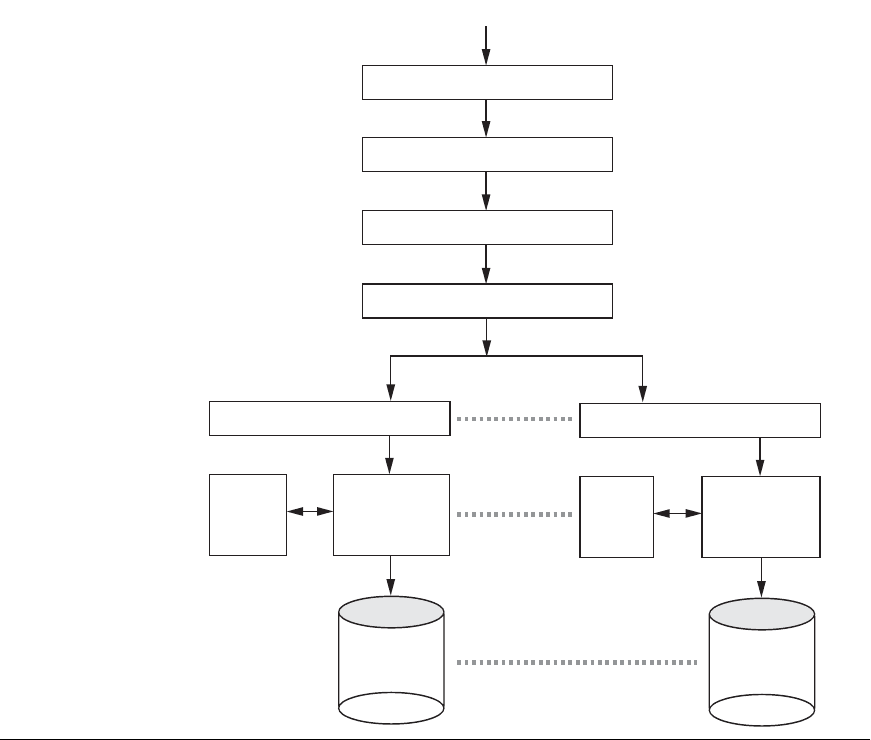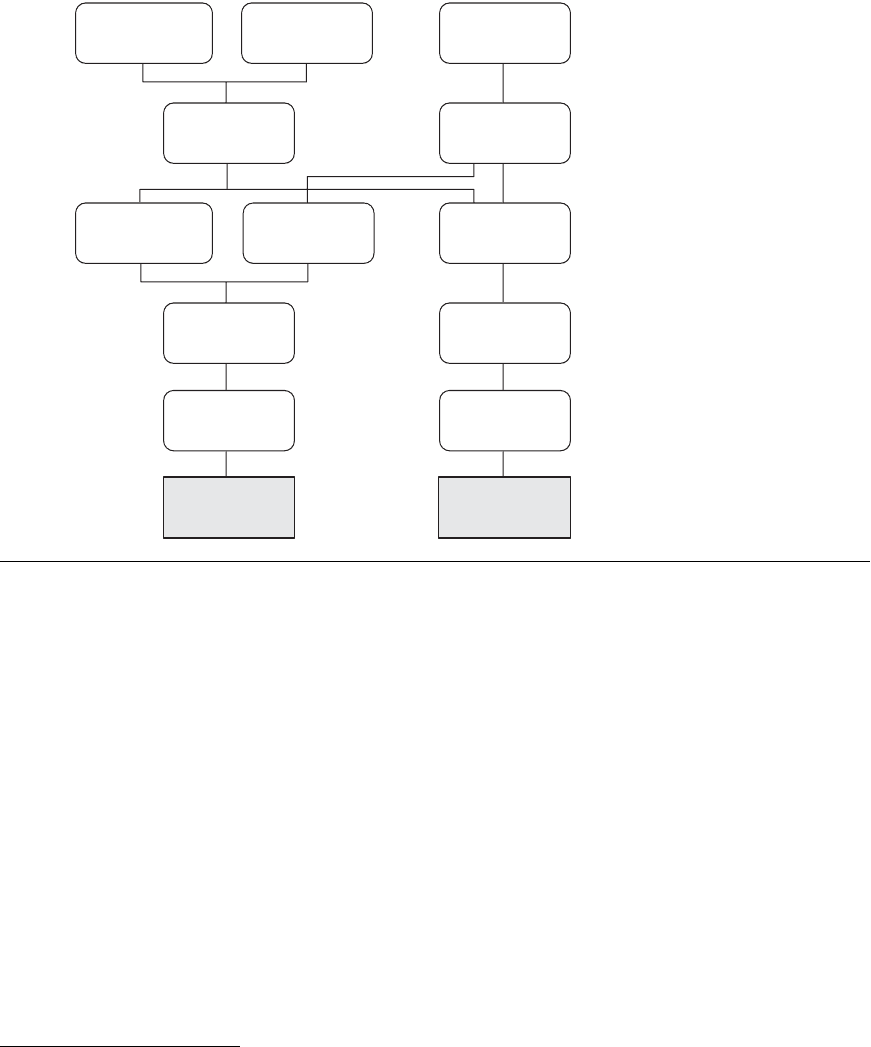Elmasri R., Navathe S.B. Fundamentals of Database Systems
Подождите немного. Документ загружается.

882 Chapter 25 Distributed Databases
25.1.5 Advantages of Distributed Databases
Organizations resort to distributed database management for various reasons.
Some important advantages are listed below.
1. Improved ease and flexibility of application development. Developing and
maintaining applications at geographically distributed sites of an organiza-
tion is facilitated owing to transparency of data distribution and control.
2. Increased reliability and availability. This is achieved by the isolation of
faults to their site of origin without affecting the other databases connected
to the network. When the data and DDBMS software are distributed over
several sites, one site may fail while other sites continue to operate. Only the
data and software that exist at the failed site cannot be accessed. This
improves both reliability and availability. Further improvement is achieved
by judiciously replicating data and software at more than one site. In a cen-
tralized system, failure at a single site makes the whole system unavailable to
all users. In a distributed database, some of the data may be unreachable, but
users may still be able to access other parts of the database. If the data in the
failed site had been replicated at another site prior to the failure, then the
user will not be affected at all.
3. Improved performance. A distributed DBMS fragments the database by
keeping the data closer to where it is needed most. Data localization reduces
the contention for CPU and I/O services and simultaneously reduces access
delays involved in wide area networks. When a large database is distributed
over multiple sites, smaller databases exist at each site. As a result, local
queries and transactions accessing data at a single site have better perfor-
mance because of the smaller local databases. In addition, each site has a
smaller number of transactions executing than if all transactions are submit-
ted to a single centralized database. Moreover, interquery and intraquery
parallelism can be achieved by executing multiple queries at different sites,
or by breaking up a query into a number of subqueries that execute in paral-
lel. This contributes to improved performance.
4. Easier expansion. In a distributed environment, expansion of the system in
terms of adding more data, increasing database sizes, or adding more proces-
sors is much easier.
The transparencies we discussed in Section 25.1.2 lead to a compromise between
ease of use and the overhead cost of providing transparency. Total transparency
provides the global user with a view of the entire DDBS as if it is a single centralized
system. Transparency is provided as a complement to autonomy, which gives the
users tighter control over local databases. Transparency features may be imple-
mented as a part of the user language, which may translate the required services into
appropriate operations. Additionally, transparency impacts the features that must
be provided by the operating system and the DBMS.
25.2 Types of Distributed Database Systems 883
25.1.6 Additional Functions of Distributed Databases
Distribution leads to increased complexity in the system design and implementa-
tion. To achieve the potential advantages listed previously, the DDBMS software
must be able to provide the following functions in addition to those of a centralized
DBMS:
■
Keeping track of data distribution. The ability to keep track of the data dis-
tribution, fragmentation, and replication by expanding the DDBMS catalog.
■
Distributed query processing. The ability to access remote sites and trans-
mit queries and data among the various sites via a communication network.
■
Distributed transaction management. The ability to devise execution
strategies for queries and transactions that access data from more than one
site and to synchronize the access to distributed data and maintain the
integrity of the overall database.
■
Replicated data management. The ability to decide which copy of a repli-
cated data item to access and to maintain the consistency of copies of a repli-
cated data item.
■
Distributed database recovery. The ability to recover from individual site
crashes and from new types of failures, such as the failure of communication
links.
■
Security. Distributed transactions must be executed with the proper man-
agement of the security of the data and the authorization/access privileges of
users.
■
Distributed directory (catalog) management. A directory contains infor-
mation (metadata) about data in the database. The directory may be global
for the entire DDB, or local for each site. The placement and distribution of
the directory are design and policy issues.
These functions themselves increase the complexity of a DDBMS over a centralized
DBMS. Before we can realize the full potential advantages of distribution, we must
find satisfactory solutions to these design issues and problems. Including all this
additional functionality is hard to accomplish, and finding optimal solutions is a
step beyond that.
25.2 Types of Distributed Database Systems
The term distributed database management system can describe various systems that
differ from one another in many respects. The main thing that all such systems have
in common is the fact that data and software are distributed over multiple sites con-
nected by some form of communication network. In this section we discuss a num-
ber of types of DDBMSs and the criteria and factors that make some of these
systems different.

884 Chapter 25 Distributed Databases
The first factor we consider is the degree of homogeneity of the DDBMS software.
If all servers (or individual local DBMSs) use identical software and all users
(clients) use identical software, the DDBMS is called homogeneous; otherwise, it is
called heterogeneous. Another factor related to the degree of homogeneity is the
degree of local autonomy. If there is no provision for the local site to function as a
standalone DBMS, then the system has no local autonomy. On the other hand, if
direct access by local transactions to a server is permitted, the system has some
degree of local autonomy.
Figure 25.2 shows classification of DDBMS alternatives along orthogonal axes of
distribution, autonomy, and heterogeneity. For a centralized database, there is com-
plete autonomy, but a total lack of distribution and heterogeneity (Point A in the
figure). We see that the degree of local autonomy provides further ground for classi-
fication into federated and multidatabase systems. At one extreme of the autonomy
spectrum, we have a DDBMS that looks like a centralized DBMS to the user, with
zero autonomy (Point B). A single conceptual schema exists, and all access to the
system is obtained through a site that is part of the DDBMS—which means that no
local autonomy exists. Along the autonomy axis we encounter two types of
DDBMSs called federated database system (Point C) and multidatabase system
(Point D). In such systems, each server is an independent and autonomous central-
ized DBMS that has its own local users, local transactions, and DBA, and hence has
B
Distribution
Heterogeneity
Legend:
A: Traditional centralized database
systems
B: Pure distributed database systems
C: Federated database systems
D: Multidatabase or peer to peer
database systems
C
D
A
Autonomy
Figure 25.2
Classification of dis-
tributed databases.

25.2 Types of Distributed Database Systems 885
a very high degree of local autonomy. The term federated database system (FDBS)
is used when there is some global view or schema of the federation of databases that
is shared by the applications (Point C). On the other hand, a multidatabase system
has full local autonomy in that it does not have a global schema but interactively
constructs one as needed by the application (Point D).
3
Both systems are hybrids
between distributed and centralized systems, and the distinction we made between
them is not strictly followed. We will refer to them as FDBSs in a generic sense. Point
D in the diagram may also stand for a system with full local autonomy and full het-
erogeneity—this could be a peer-to-peer database system (see Section 25.9.2). In a
heterogeneous FDBS, one server may be a relational DBMS, another a network
DBMS (such as Computer Associates’ IDMS or HP’S IMAGE/3000), and a third an
object DBMS (such as Object Design’s ObjectStore) or hierarchical DBMS (such as
IBM’s IMS); in such a case, it is necessary to have a canonical system language and
to include language translators to translate subqueries from the canonical language
to the language of each server.
We briefly discuss the issues affecting the design of FDBSs next.
25.2.1 Federated Database Management Systems Issues
The type of heterogeneity present in FDBSs may arise from several sources. We dis-
cuss these sources first and then point out how the different types of autonomies
contribute to a semantic heterogeneity that must be resolved in a heterogeneous
FDBS.
■
Differences in data models. Databases in an organization come from a vari-
ety of data models, including the so-called legacy models (hierarchical and
network, see Web Appendixes D and E), the relational data model, the object
data model, and even files. The modeling capabilities of the models vary.
Hence, to deal with them uniformly via a single global schema or to process
them in a single language is challenging. Even if two databases are both from
the RDBMS environment, the same information may be represented as an
attribute name, as a relation name, or as a value in different databases. This
calls for an intelligent query-processing mechanism that can relate informa-
tion based on metadata.
■
Differences in constraints. Constraint facilities for specification and imple-
mentation vary from system to system. There are comparable features that
must be reconciled in the construction of a global schema. For example, the
relationships from ER models are represented as referential integrity con-
straints in the relational model. Triggers may have to be used to implement
certain constraints in the relational model. The global schema must also deal
with potential conflicts among constraints.
3
The term multidatabase system is not easily applicable to most enterprise IT environments. The notion
of constructing a global schema as and when the need arises is not very feasible in practice for enter-
prise databases.
886 Chapter 25 Distributed Databases
■
Differences in query languages. Even with the same data model, the lan-
guages and their versions vary. For example, SQL has multiple versions like
SQL-89, SQL-92, SQL-99, and SQL:2008, and each system has its own set of
data types, comparison operators, string manipulation features, and so on.
Semantic Heterogeneity. Semantic heterogeneity occurs when there are differ-
ences in the meaning, interpretation, and intended use of the same or related data.
Semantic heterogeneity among component database systems (DBSs) creates the
biggest hurdle in designing global schemas of heterogeneous databases. The design
autonomy of component DBSs refers to their freedom of choosing the following
design parameters, which in turn affect the eventual complexity of the FDBS:
■
The universe of discourse from which the data is drawn. For example, for
two customer accounts, databases in the federation may be from the United
States and Japan and have entirely different sets of attributes about customer
accounts required by the accounting practices. Currency rate fluctuations
would also present a problem. Hence, relations in these two databases that
have identical names—
CUSTOMER or ACCOUNT—may have some com-
mon and some entirely distinct information.
■
Representation and naming. The representation and naming of data ele-
ments and the structure of the data model may be prespecified for each local
database.
■
The understanding, meaning, and subjective interpretation of data. This is
a chief contributor to semantic heterogeneity.
■
Transaction and policy constraints. These deal with serializability criteria,
compensating transactions, and other transaction policies.
■
Derivation of summaries. Aggregation, summarization, and other data-
processing features and operations supported by the system.
The above problems related to semantic heterogeneity are being faced by all major
multinational and governmental organizations in all application areas. In today’s
commercial environment, most enterprises are resorting to heterogeneous FDBSs,
having heavily invested in the development of individual database systems using
diverse data models on different platforms over the last 20 to 30 years. Enterprises
are using various forms of software—typically called the middleware, or Web-
based packages called application servers (for example, WebLogic or WebSphere)
and even generic systems, called Enterprise Resource Planning (ERP) systems (for
example, SAP, J. D. Edwards ERP)—to manage the transport of queries and transac-
tions from the global application to individual databases (with possible additional
processing for business rules) and the data from the heterogeneous database servers
to the global application. Detailed discussion of these types of software systems is
outside the scope of this book.
Just as providing the ultimate transparency is the goal of any distributed database
architecture, local component databases strive to preserve autonomy.
Communication autonomy of a component DBS refers to its ability to decide
whether to communicate with another component DBS. Execution autonomy

25.3Distributed Database Architectures 887
refers to the ability of a component DBS to execute local operations without inter-
ference from external operations by other component DBSs and its ability to decide
the order in which to execute them. The association autonomy of a component
DBS implies that it has the ability to decide whether and how much to share its
functionality (operations it supports) and resources (data it manages) with other
component DBSs. The major challenge of designing FDBSs is to let component
DBSs interoperate while still providing the above types of autonomies to them.
25.3 Distributed Database Architectures
In this section, we first briefly point out the distinction between parallel and distrib-
uted database architectures. While both are prevalent in industry today, there are
various manifestations of the distributed architectures that are continuously evolv-
ing among large enterprises. The parallel architecture is more common in high-
performance computing, where there is a need for multiprocessor architectures to
cope with the volume of data undergoing transaction processing and warehousing
applications. We then introduce a generic architecture of a distributed database.
This is followed by discussions on the architecture of three-tier client-server and
federated database systems.
25.3.1 Parallel versus Distributed Architectures
There are two main types of multiprocessor system architectures that are common-
place:
■
Shared memory (tightly coupled) architecture. Multiple processors share
secondary (disk) storage and also share primary memory.
■
Shared disk (loosely coupled) architecture. Multiple processors share sec-
ondary (disk) storage but each has their own primary memory.
These architectures enable processors to communicate without the overhead of
exchanging messages over a network.
4
Database management systems developed
using the above types of architectures are termed parallel database management
systems rather than DDBMSs, since they utilize parallel processor technology.
Another type of multiprocessor architecture is called shared nothing architecture.
In this architecture, every processor has its own primary and secondary (disk)
memory, no common memory exists, and the processors communicate over a high-
speed interconnection network (bus or switch). Although the shared nothing archi-
tecture resembles a distributed database computing environment, major differences
exist in the mode of operation. In shared nothing multiprocessor systems, there is
symmetry and homogeneity of nodes; this is not true of the distributed database
environment where heterogeneity of hardware and operating system at each node is
very common. Shared nothing architecture is also considered as an environment for
4
If both primary and secondary memories are shared, the architecture is also known as shared everything
architecture.

888 Chapter 25 Distributed Databases
parallel databases. Figure 25.3a illustrates a parallel database (shared nothing),
whereas Figure 25.3b illustrates a centralized database with distributed access and
Figure 25.3c shows a pure distributed database. We will not expand on parallel
architectures and related data management issues here.
(a)
(b)
Switch
CPU
Computer System 1
Memory
DB
CPU
Computer System 2
Memory
DB
CPU
Memory
DB
Computer System n
Central Site
(Chicago)
Site
(New York)
Site
(Los Angeles)
Site
(Atlanta)
Site
(San Francisco)
DB
1
DB
2
Communications
Network
(c)
Site 5
Site 1
Site 2
Site 4
Site 3
Communications
Network
Figure 25.3
Some different database system architectures. (a) Shared nothing architecture.
(b) A networked architecture with a centralized database at one of the sites. (c)
A truly distributed database architecture.

25.3Distributed Database Architectures 889
User
Stored
Data
Global Conceptual Schema (GCS)
External
View
User
External
View
Local Conceptual Schema (LCS) Local Conceptual Schema (LCS)
Local Internal Schema (LIS) Local Internal Schema (LIS)
Stored
Data
Site 1 Site nSites 2 to n–1
Figure 25.4
Schema architecture of
distributed databases.
25.3.2 General Architecture of Pure Distributed Databases
In this section we discuss both the logical and component architectural models of a
DDB. In Figure 25.4, which describes the generic schema architecture of a DDB, the
enterprise is presented with a consistent, unified view showing the logical structure
of underlying data across all nodes. This view is represented by the global concep-
tual schema (GCS), which provides network transparency (see Section 25.1.2). To
accommodate potential heterogeneity in the DDB, each node is shown as having its
own local internal schema (LIS) based on physical organization details at that par-
ticular site. The logical organization of data at each site is specified by the local con-
ceptual schema (LCS). The GCS, LCS, and their underlying mappings provide the
fragmentation and replication transparency discussed in Section 25.1.2. Figure 25.5
shows the component architecture of a DDB. It is an extension of its centralized
counterpart (Figure 2.3) in Chapter 2. For the sake of simplicity, common elements
are not shown here. The global query compiler references the global conceptual
schema from the global system catalog to verify and impose defined constraints.
The global query optimizer references both global and local conceptual schemas
and generates optimized local queries from global queries. It evaluates all candidate
strategies using a cost function that estimates cost based on response time (CPU,

890 Chapter 25 Distributed Databases
User
Interactive Global Query
Stored
Data
Global Query Compiler
Global Query Optimizer
Global Transaction Manager
Local Transaction Manager
Local Query
Translation
and Execution
Local
System
Catalog
Stored
Data
Local Transaction Manager
Local Query
Translation
and Execution
Local
System
Catalog
Figure 25.5
Component architecture
of distributed databases.
I/O, and network latencies) and estimated sizes of intermediate results. The latter is
particularly important in queries involving joins. Having computed the cost for
each candidate, the optimizer selects the candidate with the minimum cost for exe-
cution. Each local DBMS would have their local query optimizer, transaction man-
ager, and execution engines as well as the local system catalog, which houses the
local schemas. The global transaction manager is responsible for coordinating the
execution across multiple sites in conjunction with the local transaction manager at
those sites.
25.3.3 Federated Database Schema Architecture
Typical five-level schema architecture to support global applications in the FDBS
environment is shown in Figure 25.6. In this architecture, the local schema is the

External
schema
Federated
schema
. . .
. . .
. . .
. . .
. . .
Component
schema
Local
schema
Component
DBS
External
schema
External
schema
Federated
schema
Export
schema
Component
schema
Local
schema
Component
DBS
Export
schema
Export
schema
25.3Distributed Database Architectures 891
Figure 25.6
The five-level schema architecture
in a federated database system
(FDBS).
Source: Adapted from Sheth and
Larson, “Federated Database Systems
for Managing Distributed,
Heterogeneous, and Autonomous
Databases.” ACM Computing Surveys
(Vol. 22: No. 3, September 1990).
conceptual schema (full database definition) of a component database, and the
component schema is derived by translating the local schema into a canonical data
model or common data model (CDM) for the FDBS. Schema translation from the
local schema to the component schema is accompanied by generating mappings to
transform commands on a component schema into commands on the corres-
ponding local schema. The export schema represents the subset of a component
schema that is available to the FDBS. The federated schema is the global schema or
view, which is the result of integrating all the shareable export schemas. The
external schemas define the schema for a user group or an application, as in the
three-level schema architecture.
5
All the problems related to query processing, transaction processing, and directory
and metadata management and recovery apply to FDBSs with additional considera-
tions. It is not within our scope to discuss them in detail here.
5
For a detailed discussion of the autonomies and the five-level architecture of FDBMSs, see Sheth and
Larson (1990).
